Technology makes dreams come true in Jurassic World
This article, Technology makes dreams come true in Jurassic World, originally appeared on TechRepublic.com.
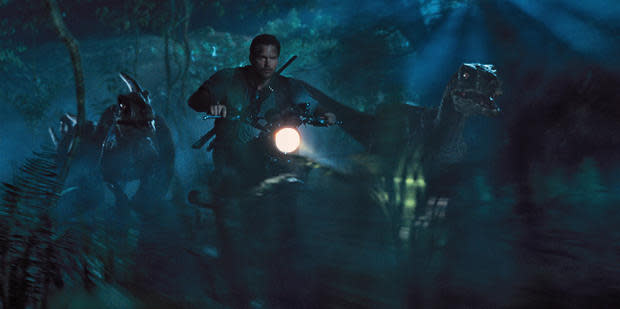
Owen (Chris Pratt) leads the raptors on a mission in "Jurassic World".
Image: Universal Pictures
World-renown paleontologist Jack Horner is gleeful. He's busy promoting the fourth and latest film in Steven Spielberg's iconic franchise, "Jurassic World," which opens today. At an event at Los Angeles' Museum of Natural History's all-new, 14,000-square-foot Dinosaur Hall, Horner, technical advisor on all four "Jurassic" films, prepares to speak on his favorite topic: (unsurprisingly) dinosaurs.
Prolific author and researcher Horner has serious street cred and bragging rights and is the real-life inspiration for Sam Neill's ubiquitous "Jurassic" paleontologist, "Alan Grant." Horner's smile grows wider, when asked about characteristics critical to "Jurassic World's" new hybrid dinosaur, Indominus Rex. "We got to include something I've wanted for a long time, all these years..." He pauses dramatically (yes, he has a cameo in the new movie), and says in a loud whisper: "Camouflage!"
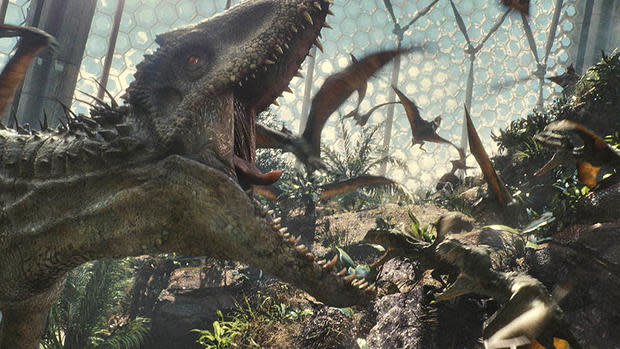
The Indominus rex dominates all creatures in her path in "Jurassic World".
Image: ILM/Universal Pictures
Horner may be most excited by the credible quality of camouflage (a frightening addition to the genetically engineered dinosaurs which populate the latest franchise installment), but Steven Spielberg loves the thrill. Both Horner and "Jurassic World" director Colin Trevorrow have noted: Steven Spielberg is all about the scare factor. And boy, do they bring it, with the terrifying created-in-a-lab hybrid. Jurassic World is also the name of the new and elaborate entertainment complex, located in the same location as the original "Jurassic Park." Events are set two decades later and the island destination is an extremely popular one.
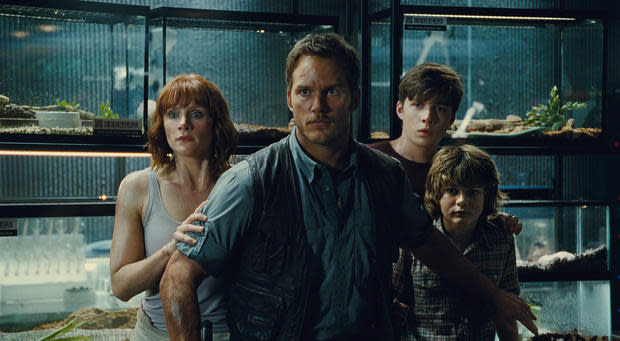
(L to R) Claire (Bryce Dallas Howard), Owen (Chris Pratt), Zach (Nick Robinson) and Gray (Ty Simpkins) watch in terror in "Jurassic World".
Image: Universal Pictures
Trevorrow has said the movie explores two elements of modern-day society: how money often fuels our biggest mistakes, noting, "it was clear from the first film that humanity" thought it could control nature, which "rarely works out well," but people continue to do so in the hopes of making "heaps and heaps" of money. Secondly, Trevorrow notes how "technology has become such an inherent part of our lives that we've become numb to scientific miracles around us. We wanted to explore a world where science has brought back dinosaurs and people are just kind of, 'over it,' already." The greedy corporate backers are anxious to lure more than the 20,000 daily visitors to Jurassic World, the old: make it better, make it bigger. And, Indominus Rex is created, to wreak havoc. And, is a dinosaur original author, Michael Crichton, originally conceived. Crichton died in 2008.
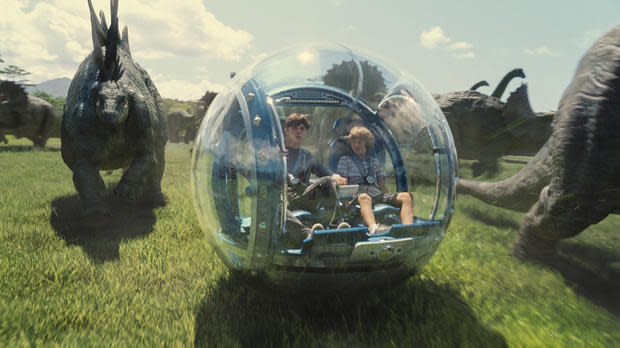
Visitors to Jurassic World roam among the dinosaurs in giant "hamster balls".
Image: ILM/Universal Pictures
The majority of "most of the shots of dinosaurs" in the first three installments -- "Jurassic Park" (1993), "The Lost World: Jurassic Park" (1997), and "Jurassic Park III," (2001) -- were animatronic, says Horner, who adds, "and looking at it now, you can tell which ones were animatronic." He explains, "we decided, in 'Jurassic Park' one, and I worked with the ILM people [effects/Industrial Light & Magic], and we came to agreements on how [the dinosaurs] would move, based mostly on birds."
The technology for getting the various dinosaurs on screen, he says, "has changed...in this one, it's all computer graphics, which shows how much computer graphics have changed."
Well, not quite. Trevorrow actually did use an animatronic dinosaur, apparently as a way of paying tribute to special effects legend, the late Stan Winston, who died in 2008. It was Winston who created the T-Rex, Velociraptor and Brachiosaurus in the original films. Trevorrow supposedly felt an animatronic dinosaur would help the actors achieve "the right intensity for their interactions with the giant creature."
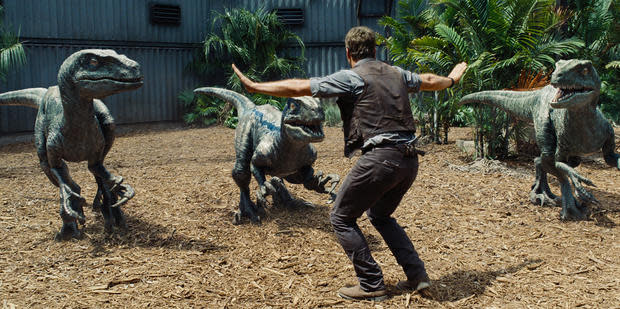
Owen (Chris Pratt) attempts to keep the raptors at bay in "Jurassic World".
Image: Universal Pictures
So former Stan Winston-mentee and associate, John Rosengrant, as well as his team at Legacy Effects, spent three months creating "Jurassic World's" Apatosaurus, which was then operated by Rosengrant and four puppeteers for filming. Apatosaurus can lift and turn its head, breathe through its nose and mouth, as well as blink and twitch its eyes.
Rosengrant, in Hawaii to film the Apatosaurus scenes, said, "Because it was shot in the middle of nowhere, we were careful not to overbuild and used tried-and-true methods of construction and puppeteering/animatronic controls."
He explains, "The advancements have come mostly in how we sculpt and create rather than the control systems -- although those are more streamlined now -- radio controls have improved, allowing greater flexibility in dialing in nuanced movements ... But the use of digital sculpting and rapid prototyping has cut our preproduction time way down."
Rosengrant, who has been a part of the franchise since the beginning, adds "It's been great to be part of all the Jurassic Movies, they feel like part of my DNA and an honor to have the opportunity to help bring more iconic dinosaurs to the screen."
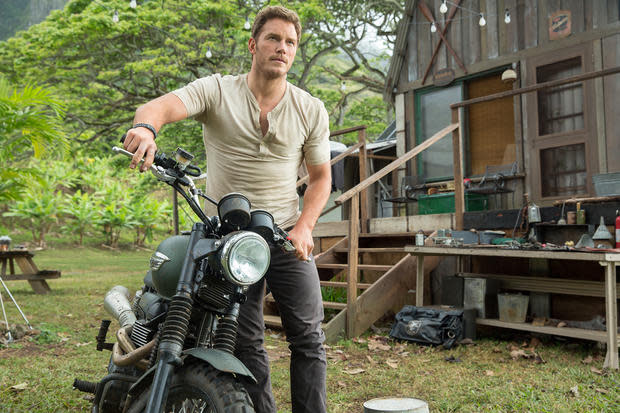
Chris Pratt as a behavioral researcher in "Jurassic World".
Image: Chuck Zlotnick
Between the empathy the animatronic Apatosaurus brings and what Horner says is the dinosaurs' "smooth[er] flow" of movement, the emotion and realism are there. "The dinosaurs in this film are superb," Horner adds.
Horner points out that right when the first film was released, the revelation of the connection between dinosaurs and birds was confirmed. It's pretty clear dinosaurs had feathers (and colorful ones at that, Horner adds). So why no feathers on the uber-real dinosaurs in "Jurassic World?" "For continuity," Horner says matter-of-factly. "It hadn't been reflected in any of the other films, and they needed consistency." Horner posits: it's quite possible T-Rex not only had feathers, but pink ones (flamingos, anyone?). But, he qualifies, "not exactly scary." And Spielberg loves the fear factor - and if the buzz tells us anything, so do audiences.

Paleontologist Jack Horner was the inspiration for Sam Neill's original character in the Jurassic films.
Image: Alex J. Berliner, AP

